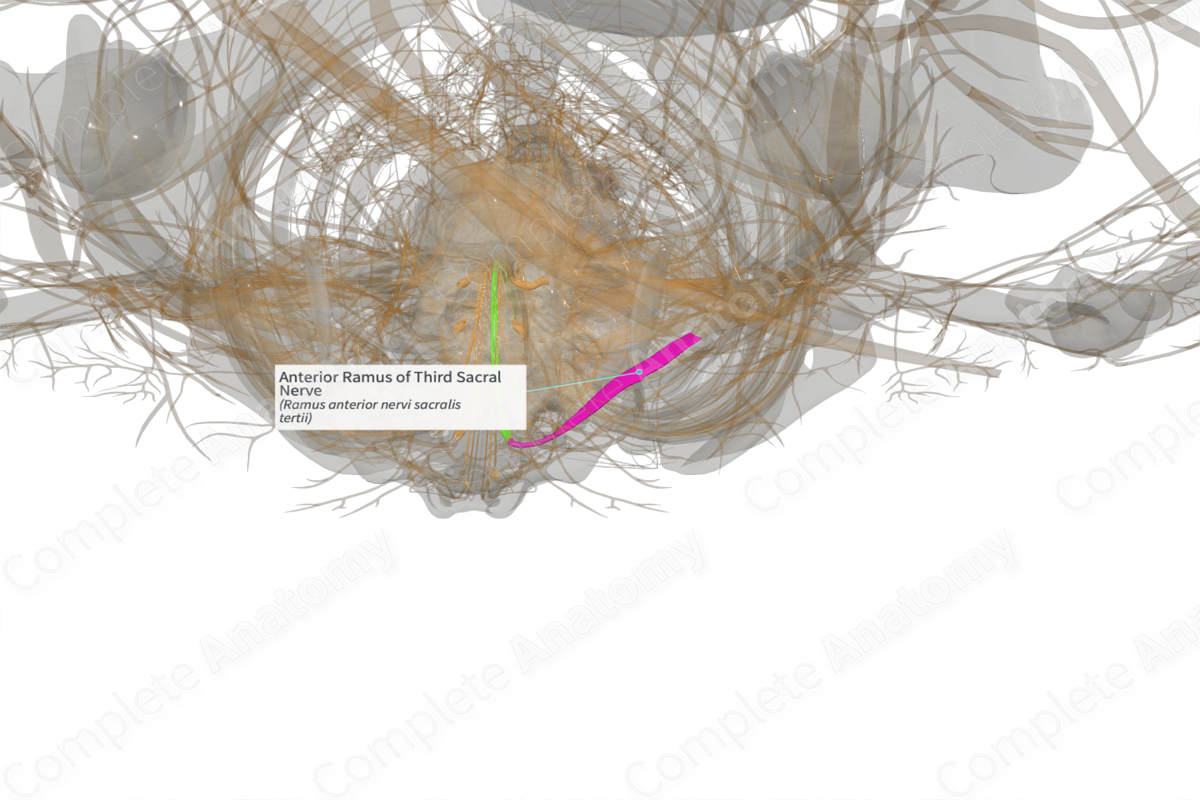
Anterior Ramus of Third Sacral Nerve (Left)
Ramus anterior nervi sacralis tertii
Read moreQuick Facts
Origin: Third sacral nerve (S3).
Course: Emerges from the anterior sacral foramen and passes laterally to lie on the piriformis muscle.
Branches: Sciatic and tibial nerves, and posterior and perforating cutaneous nerves of the thigh.
Supply: Motor innervation to the leg and foot muscles. Sensory innervation to the posterior aspect of the thigh and/or leg region.
Origin
The anterior ramus of third sacral nerve originates as one of two branches of the third sacral nerve, the other branch being the posterior ramus.
Course
The anterior ramus of third sacral nerve passes out from its respective anterior sacral foramen on the anterior surface of the sacrum. It then passes behind the lateral sacral artery and comes to lie in front of the piriformis muscle, as it courses laterally and inferiorly on the pelvic wall.
The anterior ramus of third sacral nerve further divides into anterior and posterior divisions which contribute to the sacral plexus. The plexus is situated on the posterolateral pelvic wall, on the anterior surface of piriformis muscle, deep to internal iliac vessels.
Branches
The anterior ramus of third sacral nerve is a mixed nerve as it contains both somatic efferent (motor) and afferent (sensory) neurons.
The somatic efferent neurons emerge from the anterior gray horn of the third sacral segment of the spinal cord. These are lower motor neurons which exit the spinal cord through the anterolateral sulcus, as they travel inside the anterior motor rootlets and root of third sacral spinal segment. They subsequently travel through the third sacral nerve to enter the anterior ramus before reaching the sacral plexus.
The efferent neurons eventually enter the posterior compartment of the leg and the foot via the tibial nerve and its branches.
The somatic afferent neurons travel through the posterior cutaneous nerve of the thigh and the perforating cutaneous nerve to enter the sacral plexus. From the sacral plexus onwards, these neurons travel through the sensory root and rootlets of the third sacral nerve. The cell bodies of these neurons are located inside the posterior root ganglion of the third sacral nerve. The axons then travel through the posterolateral sulcus to enter the right posterior sensory horn of the third sacral spinal cord segment.
The anterior ramus of third sacral nerve is also connected to the sympathetic trunk through the gray communicating branch (ramus communicans), which serves as a conduit for the postganglionic sympathetic neurons.
The pelvic splanchnic nerves contain preganglionic parasympathetic neurons. These travel towards the inferior hypogastric plexus to synapse with the cell bodies of the postganglionic neurons to innervate the pelvic viscera and genitalia.
Supplied Structures
The anterior ramus of third sacral nerve supplies motor innervation, through the somatic efferent neurons, to the flexor hallucis longus and flexor digitorum longus muscles in the posterior compartment of the leg. The efferent neurons also travel through muscular branches of the sciatic nerve to innervate muscles in the foot region (abductor hallucis, flexor digitorum brevis, abductor digiti minimi, quadratus plantae (flexor accessorius), lumbricals, adductor hallucis, flexor digiti minimi brevis, and the palmar and posterior interossei muscles).
The somatic afferent neurons conduct cutaneous general sensory information from the posterior aspect of the thigh and/or leg region (and buttocks) through the posterior and perforating cutaneous nerves of the thigh.




